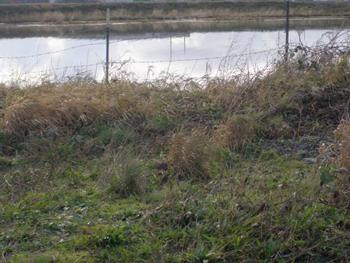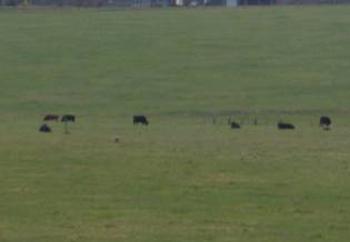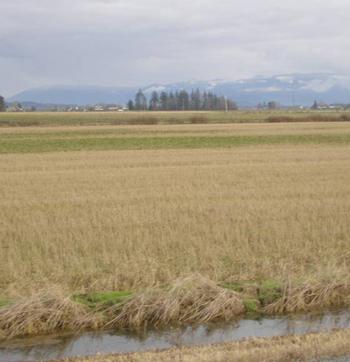Easy Feed Coyote Hunting
By Eric B.
Wiley Coyote, where are you? I have asked myself this question plenty of times. And I've found plenty of answers to this question throughout the year. I have narrowed it down to a couple of these areas to try throughout the year. These areas can be useful for both the beginning coyote hunter and the general predator hunter to try.
The hunting areas I will suggest share one major factor: easy feed. Anywhere that there is easy feed there will likely be predators. It helps to look for special food sources in select areas during certain times of the year. Whether it is deer, upland birds, waterfowl or cattle, it's all about easy feed. You've just got to do the research.

A big, deep water area where wounded birds can go. A lot of birds in general just like to rest up here and stay put.
The time of year matters for all of these areas. Take fall deer season for example, when most often people are out deer hunting. With harvested deer and wounded deer around, coyotes will be actively searching for gut piles, chasing down wounded deer, and so on. Trying to find these areas can be tricky, but most often the more heavily pressured deer hunting areas will be best. The deer will be kept on the move, and so will the coyotes. If you're really lucky, you might even get both coyotes and deer.

A larger farm with plenty of cattle that will give birth to calves around April, so that means April Coyote Shoot is planned.
During the fall, many states also release human raised upland birds like pheasants, quail, and other species in specific hunting areas and zones. This is like bait for coyotes. I have seen multiple coyotes follow the release truck carrying the birds into these areas like a couple of bird dogs. So do a search of bird release times at any fish and game website and then see if any coyotes are visiting the areas. Keep looking around for other areas and you should improve your odds.
During late fall and the beginning of winter, most areas have a good waterfowl season that lasts until about January or February. With waterfowl season there are many wounded birds, and a lot of birds spending the nights on the water. Wounded birds from bird hunters are pretty easy for coyotes to take. This can also be a peak coyote harvesting time. Coyotes tend to be on the move in the winter, so this adds to the effect as well. During this time of year, most lakes where I hunt are beginning to freeze fairly well, so a lot of coyotes will be spooking birds off the ice or will be in the general area.

This public farm field where ducks and geese feed has been a producer of coyotes.
At one refuge where I was looking for geese and ducks and observing how many coyotes were in the area, I saw seven coyotes on the ice and in the beach area. Two of them had found dead birds that had come back to the water. Unfortunately, I couldn't harvest the coyotes because the lakes were a refuge and against the law to hunt. This water bird idea applies to many water areas that are open for hunting. For example, rivers that stay open would be good areas to hunt, such as the Clearwater and Snake Rivers. Other open water sources such as the hot springs in Montana would be great places to look for bird concentrations.
Many states have public waterfowl hunting areas. There are huge numbers of wounded game birds in these areas, and coyotes can be found there frequently. Some examples of these areas are state lands and lands purchased by Ducks Unlimited. But be sure to read the regulations thoroughly. In some of these areas you can't hunt with rifles for very good reason. However, you can possibly hunt just over the property line and wait for the coyotes to come. On multiple occasions I have seen a duck or goose killed, then from out of the brush coyotes appeared, grabbed the bird, and left. Wounded or dead birds are extremely enticing for a coyote. When dealing with public land hunting areas, be sure to read the regulations and signs. Be careful, and get permission, tags or special permits for these areas when needed.
Another good time for coyote hunting is from around February until around May. Although birthing of cattle can be almost anytime, most often I have found it to be during this time. This is when farmers can become your best friends. Last February alone in one small area where cattle were birthing, I saw at least fifteen coyotes in about two hours. If the cows and farmers aren't on guard, the calves will be coyote food. Hunting opportunities in these areas depend on the density of coyotes, other food sources, and the type of weather. Farmers really don't like coyotes, so this is the time of year is when knocking on a few doors can definitely pay off. Most the time you won't get shot down. Farmers worry about their cattle, dogs, chickens, or whatever animals they have on their property, so having a few less coyotes around is always a good thing for them.
There is one thing I purposely neglected to mention, which is calling for coyotes. In the areas I mentioned it is mostly all about sitting and waiting, which can be successful or not. But learning to call is essential. The addition of calling to most of these areas, and to other areas in general, will produce a lot more for you. These areas are great places to start calling and to gain confidence in calling. With a little bit of confidence built up, you can then go and explore other areas that require calling to be successful. Eventually you can have dozens of spots to go to for a fun day of coyote hunting. The coyote is a very wily predator, so that means you must start thinking like a wily predator yourself. So good luck to everybody on his or her hunting adventures this season.
By Eric B.
Wiley Coyote, where are you? I have asked myself this question plenty of times. And I've found plenty of answers to this question throughout the year. I have narrowed it down to a couple of these areas to try throughout the year. These areas can be useful for both the beginning coyote hunter and the general predator hunter to try.
The hunting areas I will suggest share one major factor: easy feed. Anywhere that there is easy feed there will likely be predators. It helps to look for special food sources in select areas during certain times of the year. Whether it is deer, upland birds, waterfowl or cattle, it's all about easy feed. You've just got to do the research.

A big, deep water area where wounded birds can go. A lot of birds in general just like to rest up here and stay put.
The time of year matters for all of these areas. Take fall deer season for example, when most often people are out deer hunting. With harvested deer and wounded deer around, coyotes will be actively searching for gut piles, chasing down wounded deer, and so on. Trying to find these areas can be tricky, but most often the more heavily pressured deer hunting areas will be best. The deer will be kept on the move, and so will the coyotes. If you're really lucky, you might even get both coyotes and deer.

A larger farm with plenty of cattle that will give birth to calves around April, so that means April Coyote Shoot is planned.
During the fall, many states also release human raised upland birds like pheasants, quail, and other species in specific hunting areas and zones. This is like bait for coyotes. I have seen multiple coyotes follow the release truck carrying the birds into these areas like a couple of bird dogs. So do a search of bird release times at any fish and game website and then see if any coyotes are visiting the areas. Keep looking around for other areas and you should improve your odds.
During late fall and the beginning of winter, most areas have a good waterfowl season that lasts until about January or February. With waterfowl season there are many wounded birds, and a lot of birds spending the nights on the water. Wounded birds from bird hunters are pretty easy for coyotes to take. This can also be a peak coyote harvesting time. Coyotes tend to be on the move in the winter, so this adds to the effect as well. During this time of year, most lakes where I hunt are beginning to freeze fairly well, so a lot of coyotes will be spooking birds off the ice or will be in the general area.

This public farm field where ducks and geese feed has been a producer of coyotes.
At one refuge where I was looking for geese and ducks and observing how many coyotes were in the area, I saw seven coyotes on the ice and in the beach area. Two of them had found dead birds that had come back to the water. Unfortunately, I couldn't harvest the coyotes because the lakes were a refuge and against the law to hunt. This water bird idea applies to many water areas that are open for hunting. For example, rivers that stay open would be good areas to hunt, such as the Clearwater and Snake Rivers. Other open water sources such as the hot springs in Montana would be great places to look for bird concentrations.
Many states have public waterfowl hunting areas. There are huge numbers of wounded game birds in these areas, and coyotes can be found there frequently. Some examples of these areas are state lands and lands purchased by Ducks Unlimited. But be sure to read the regulations thoroughly. In some of these areas you can't hunt with rifles for very good reason. However, you can possibly hunt just over the property line and wait for the coyotes to come. On multiple occasions I have seen a duck or goose killed, then from out of the brush coyotes appeared, grabbed the bird, and left. Wounded or dead birds are extremely enticing for a coyote. When dealing with public land hunting areas, be sure to read the regulations and signs. Be careful, and get permission, tags or special permits for these areas when needed.
Another good time for coyote hunting is from around February until around May. Although birthing of cattle can be almost anytime, most often I have found it to be during this time. This is when farmers can become your best friends. Last February alone in one small area where cattle were birthing, I saw at least fifteen coyotes in about two hours. If the cows and farmers aren't on guard, the calves will be coyote food. Hunting opportunities in these areas depend on the density of coyotes, other food sources, and the type of weather. Farmers really don't like coyotes, so this is the time of year is when knocking on a few doors can definitely pay off. Most the time you won't get shot down. Farmers worry about their cattle, dogs, chickens, or whatever animals they have on their property, so having a few less coyotes around is always a good thing for them.
There is one thing I purposely neglected to mention, which is calling for coyotes. In the areas I mentioned it is mostly all about sitting and waiting, which can be successful or not. But learning to call is essential. The addition of calling to most of these areas, and to other areas in general, will produce a lot more for you. These areas are great places to start calling and to gain confidence in calling. With a little bit of confidence built up, you can then go and explore other areas that require calling to be successful. Eventually you can have dozens of spots to go to for a fun day of coyote hunting. The coyote is a very wily predator, so that means you must start thinking like a wily predator yourself. So good luck to everybody on his or her hunting adventures this season.

